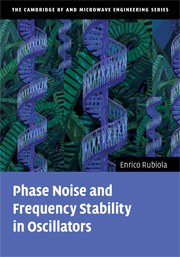Book contents
- Frontmatter
- Contents
- Foreword by Lute Maleki
- Foreword by David Leeson
- Preface
- Notation
- 1 Phase noise and frequency stability
- 2 Phase noise in semiconductors and amplifiers
- 3 Heuristic approach to the Leeson effect
- 4 Phase noise and feedback theory
- 5 Noise in delay-line oscillators and lasers
- 6 Oscillator hacking
- Appendix A Laplace transforms
- References
- Index
5 - Noise in delay-line oscillators and lasers
Published online by Cambridge University Press: 24 January 2011
- Frontmatter
- Contents
- Foreword by Lute Maleki
- Foreword by David Leeson
- Preface
- Notation
- 1 Phase noise and frequency stability
- 2 Phase noise in semiconductors and amplifiers
- 3 Heuristic approach to the Leeson effect
- 4 Phase noise and feedback theory
- 5 Noise in delay-line oscillators and lasers
- 6 Oscillator hacking
- Appendix A Laplace transforms
- References
- Index
Summary
The basic delay-line oscillator, shown in Fig. 5.1, is an oscillator in which the feedback path has a delay τd that is independent of frequency. Hence, when the amplifier gain A = 1, the Barkhausen condition is met at any frequency ωl = (2π/τd)l with l integer, that is, a frequency multiple of the free spectral range 2π/τd. With appropriate initial conditions, stationary oscillation takes place. If the exact condition A = 1 is met in a frequency range, several oscillation frequencies may coexist.
A real oscillator requires a small-signal gain A > 1 that reduces to unity in appropriate large-signal conditions. Of course, a selector filter is necessary in order to choose a mode m and thus a frequency ωm = (2π/τd)m. The filter introduces attenuation at all frequencies ωl with l ≠ m. For laboratory demonstration purposes, the imperfect gain flatness as a function of frequency of real amplifiers is sufficient to select a mode, albeit an arbitrary one. A true band-pass filter is necessary for practical applications. Using a tunable filter the oscillation frequency can be switched between modes, as in a synthesizer, in steps Δω = 2π/τd.
It will be shown that the laser is a special case of a delay-line oscillator. Additionally, the delay-line oscillator is of great interest for the generation of microwaves and THz waves from optics because a long delay can be implemented thanks to the high transparency of some materials, such as silica, CaF2, and MgF2, at 1.55 μm wavelength.
- Type
- Chapter
- Information
- Phase Noise and Frequency Stability in Oscillators , pp. 125 - 149Publisher: Cambridge University PressPrint publication year: 2008

